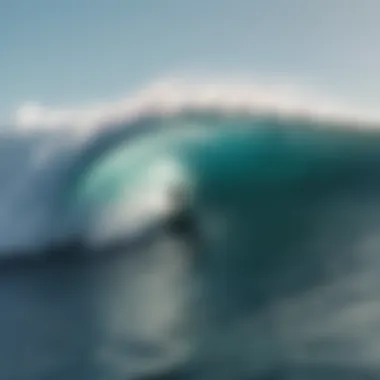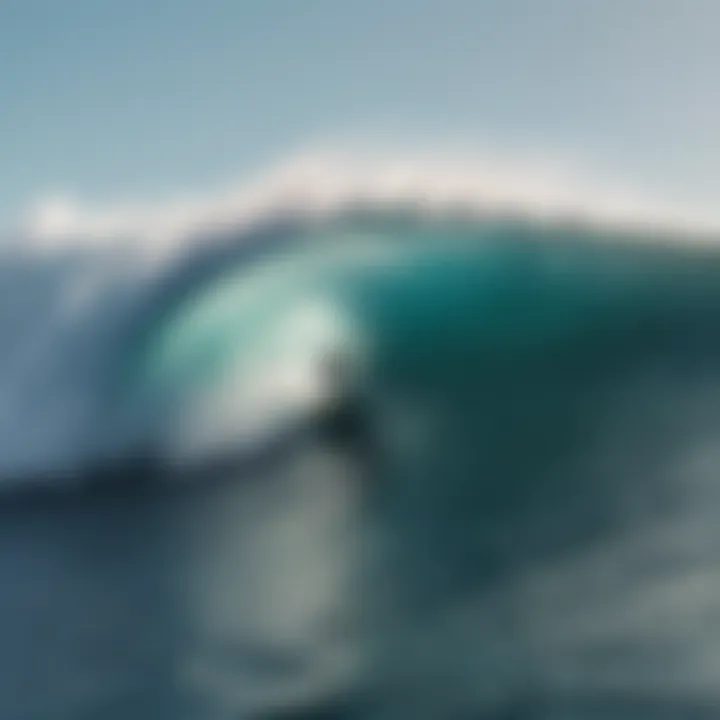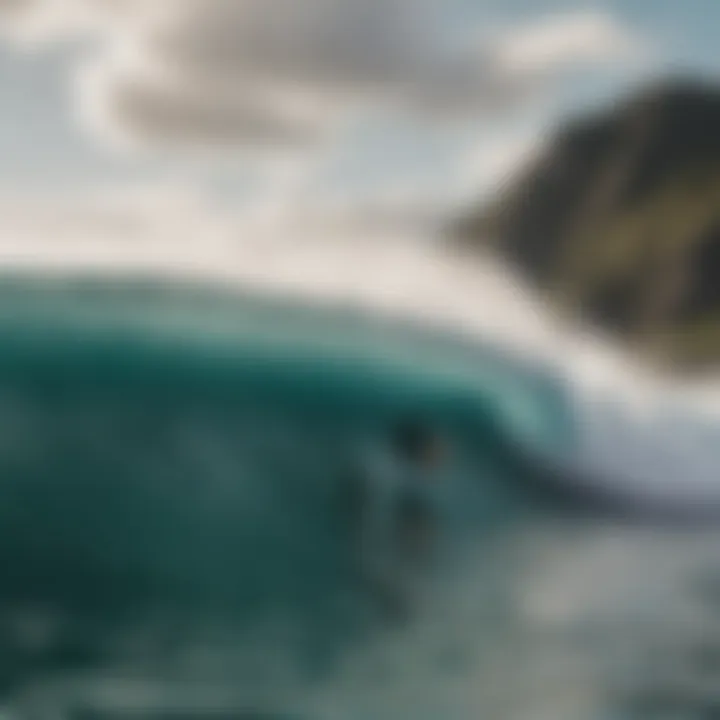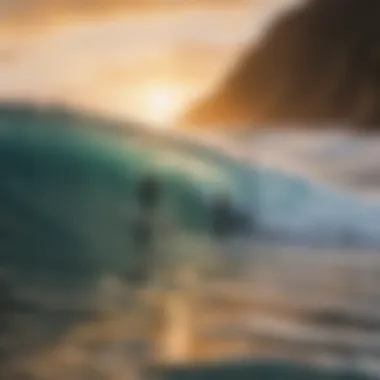Navigating the Depths of Ocean Surfing


Intro
Ocean surfing is not merely a sport; it’s a dance with nature, an intricate blend of skill and instinct. From beginners paddling into small waves on a sunny day to seasoned surfers riding powerful swells, each session offers a unique blend of challenge and exhilaration. This article takes a close look at the many facets involved in surfing, helping both newbies and veterans alike to surf with respect for the ocean and its ways. We’ll explore essential techniques, the gear that enhances performance, and the pressing need for sustainable practices in this beloved pastime.
Techniques and Skills
Essential Techniques for Beginners
For those just starting their surfing journey, mastering a few foundational techniques can provide a smoother introduction. Here are some key practices:
- Paddling: The most critical skill for getting out to the waves. Start by lying flat on your board and using strong, steady strokes. It’s like a full-body workout, engaging your arms, core, and legs.
- Pop-Up: Transitioning from lying on your board to standing takes practice. Begin in a prone position. As you ride a wave, use your arms to push up while bringing your feet underneath you. Timing is everything, and it might feel clunky at first.
- Balance: Finding your center of gravity on the board is paramount. Bend your knees slightly, keep your feet shoulder-width apart, and engage your core for stability. It’s akin to balancing on a narrow beam during a circus act.
Advanced Skills for Experienced Watersport Enthusiasts
As surfers advance in skill, the techniques become more complex, requiring a blend of athleticism and finesse:
- Carving: This involves turning sharply on the wave, which allows for more control and style. It’s all about shifting your weight and utilizing your hips and shoulders.
- Cutbacks: These are more advanced maneuvers that allow surfers to regain lost speed while maintaining flow. You engage the rail of your board and redirect your momentum back toward the wave face.
- Aerials: For the thrill-seekers, launching off the lip of a wave is the ultimate expression of skill and bravery in surfing. This requires precise timing and an intimate understanding of the wave's dynamics.
Equipment and Gear
Must-Have Gear for Each Watersport
Every surfer knows the importance of suitable equipment. Regardless of your experience level, proper gear can greatly influence performance:
- Surfboard: The most critical piece of equipment. Beginners might prefer soft-top boards for safety and stability. Advanced surfers usually opt for performance boards that provide agility and speed.
- Wetsuit: Depending on water temperature, a durable wetsuit is essential for comfort and movement. Choose thickness based on local conditions.
- Leash: Often overlooked, this tether keeps your board attached to you, preventing it from drifting away when you wipe out.
Tips for Selecting the Right Equipment
Choosing the right surf gear is crucial and sometimes overwhelming. Consider these tips while shopping:
- Personal Fit: Always select equipment that addresses your specific needs. For instance, a heavier surfer might need a longer board for stability, while lighter surfers can opt for shorter boards.
- Environment: Think about the conditions where you’ll be surfing. Reef breaks require a stronger board while beach breaks may call for more versatile gear.
- Budget: Quality matters, but it doesn’t always require breaking the bank. Look for good second-hand options or rent gear initially.
"Surfing is not just a sport. It’s a community of like-minded individuals who share a passion for the ocean."
Embracing these techniques and understanding the nuances of equipment elevates not only the surfing experience but also one's respect for the ocean. As we journey through the waves, it becomes clear that sustainable practices must parallel our pursuit of mastering this art and science.
The Essence of Surfing
Surfing embodies more than just a sport; it is a dance with nature, a way to engage with the ever-changing rhythms of the ocean. Every wave tells a story, and riders who master the art develop an intrinsic connection to the water. Understanding the essence of surfing is crucial in grasping the broader narrative of both individual experiences and collective culture around this watery playground. The blend of physical prowess, mental stamina, and emotional insight makes surfing special. It offers not just adrenaline but a path to personal growth and freedom.
Historical Overview
Surfing has roots that stretch deep into history, tracing back over a thousand years in Polynesian culture. The ancient Hawaiians crafted wooden boards and rode the waves, instilling a sense of reverence for the ocean. For them, surfing was not merely entertainment; it was a way of connecting with their ancestors and the spirit of the sea. Notably, the sport gained prominence in the early 20th century, particularly during the 1950s when it exploded into a global phenomenon. The Beach Boys, surf movies, and iconic surf spots like Malibu propelled surfing into the American consciousness.
As time marched on, surf culture evolved. Not only did boards change—reflecting innovations in materials and design—but so did the ride itself. Different styles emerged: from the smooth, graceful lines of longboard riding to the sharp, agile maneuvers of shortboarding. Each style tells a different tale of the surf experience, guiding surfers in how they tackle the swells.
Cultural Significance
Surfing is laden with cultural significance across various regions. It reflects the lifestyles of coastal communities, serving as a common thread that ties together diverse groups ranging from laid-back beach bums to competitive athletes. Surfing fosters camaraderie among those drawn to riding waves, creating strong communities around shared experiences and values.
In many ways, it acts as a cultural bridge. "Surfing culture is like a universal language; it transcends borders and unites people with a passion for the ocean." Whether in the enchanting beaches of Bali or the rugged coasts of California, every surfer adds to a colorful tapestry filled with stories, adventures, and friendships. Moreover, local traditions often intertwine with contemporary surfing practices, blending rich heritage with modern techniques and ideologies.
The activity has also found its way into art and literature, influencing everything from painting to poetry. Artists depict the raw beauty of waves and the grace of surfers—reflecting how this sport captures the essence of freedom and connection to nature.
In sum, understanding the essence of surfing opens up a world where history, culture, and personal connection come together, enhancing not only the experience of riding waves but enriching the soul.
Understanding Ocean Dynamics
Understanding the dynamics of the ocean is at the heart of surfing. Wave formation, tides, and the weather all play pivotal roles in creating the conditions that surfers both love and respect. By having a solid grasp of these elements, surfers can make informed decisions about when and where to ride the waves. This section unpacks the science behind ocean dynamics, helping surfers of all skill levels enhance their experience on the water.
Wave Formation and Types
Waves are born from wind interacting with the ocean's surface. This relationship is driven by several factors, such as wind speed, direction, and the duration for which the wind blows over the water. There’s a special language to describe waves, some of which might sound technical at first.
- Fetch: The distance over which the wind blows. A longer fetch produces bigger waves.
- Swells: These are waves that have traveled far from their point of origin and can create ideal surfing conditions. Swells are generally smoother and more organized compared to choppy waves.
- Breaking Waves: When a wave gets shallow or steep, it will start to break. Depending on the seabed's shape and depth, break types can vary:
- Beach Breaks: These occur on sandy bottoms and can change frequently with tide and wind.
- Reef Breaks: More consistent than beach breaks, these break over rocky areas and can create powerful, tubular waves.
- Point Breaks: Waves that break in one direction, usually wrapping around an obstacle like a point in the coastline.


The variety of wave types each offers unique experiences, and knowing your wave can be the difference between a thrilling ride and a wipeout.
Tides and Currents
Tides are the rhythmic rise and fall of sea levels caused by gravitational forces exerted by the moon and the sun. The influence of tides on surfing cannot be understated. Different surf spots react uniquely to changing tides. For example, some spots may be better at high tide, while others shine at low tide. Here’s what to consider:
- High Tide: Can create a more forgiving landing for beginners but might wash out some of the breaks.
- Low Tide: Often reveals more defined wave shapes, but can be riskier due to exposed rocks or shallow reefs.
Currents, on the other hand, are like rivers within the ocean. They can either assist or hinder a surfer's efforts, depending on their strength and direction. Understanding local currents is crucial not just for performance but for safety. Rip currents, for example, can be dangerous for those unfamiliar with how to escape or navigate them.
Weather Influence on Surfing Conditions
Weather patterns significantly impact surfing conditions. From daily fluctuations to seasonal storms, there's a lot to keep tabs on.
- Seasonal Changes: In many regions, specific seasons bring bigger swells due to storm activity. The winter months in the Northern Hemisphere often produce powerful ocean swells ideal for experienced surfers, while summer might cater to beginners with smaller, more manageable waves.
- Local Forecasting: Surf forecasting websites can be excellent resources. They use technology to track swell size, wind conditions, and tide timings, providing surfers with real-time data.
- Wind Direction: Offshore winds, which blow from land to sea, can create clean, perfect conditions for surfing. Conversely, onshore winds create choppy waves and can detract from a good surfing experience.
Understanding these weather-related factors allows surfers to pick optimal surf days. Ignoring them can lead to unexpected and potentially hazardous situations.
Recognizing these ocean dynamics empowers surfers, ensuring they can not only ride the waves effectively but also respect the ocean's ever-changing nature.
Essential Surfing Techniques
Engaging with the waves isn’t just about jumping on a board and hoping for the best. Mastering the fundamentals of surfing techniques can make all the difference between catching that perfect wave or taking a tumble into the surf. Whether a novice or someone looking to sharpen their skills, understanding these techniques is not just advisable but essential. Each aspect of surfing, from paddling to riding the wave, requires thoughtful practice and a keen awareness of the ocean's dynamics.
Paddling Fundamentals
Getting out into the water starts with effective paddling, which might seem straightforward, but it encompasses more than mere arm movement. Paddling is where surfers build momentum to reach the waves and set up for what comes next. To begin, a strong, coordinated stroke using both arms is crucial. Keep your hands flat and fingers spread when they enter the water, ensuring maximum surface area to create pull.
Two principles are fundamental here: utilize your core muscles for added power and keep your body in a streamlined position to minimize drag. Focus on the rhythm. It's akin to swimming as if you’re in a synchronized dance with the ocean.
Positioning and Timing
Once paddling is in the bag, the next hurdle is positioning and timing. This stage is about knowing where to sit on your board relative to the incoming waves and when to initiate movement. Locating the right spot can be a challenge, especially when the surf gets crowded. Position plays a vital role in wave selection; you want to secure your place on the board just beyond where the wave begins to crest.
The tricky part is timing your takeoff. Surfers often miss rallies because they either paddle too soon or too late. Patience is key here, as timing needs to synchronize with the wave’s energy. When the wave starts to lift, it’s your cue to make your move.
Mastering the Takeoff
The takeoff is a pivotal moment that dictates your ride, so the execution of this maneuver should be thorough. As you sense the wave's lift, push down on your board’s tail while simultaneously pulling up your body, transitioning from a prone position to standing. This shift requires balance; the center of gravity should be low.
A well-timed takeoff allows you to harness the wave's energy effectively, leading to a smoother transition into riding. Many surfers find it helpful to practice on the sand, mimicking the motion before hitting the waves. A good takeoff can make you feel as if you’re flying, while a shaky attempt may lead to a face-full of saltwater.
Riding the Wave
Ah, the exhilarating moment of riding the wave. It's what every surfer dreams of—the feeling of gliding on the water's surface while the world rushes by. However, riding requires not just bravery but also skill and keen observation.
Once you’re up, shift your weight wisely. Leaning too far back could throw you off balance, while too much weight forward may send you tumbling. It’s about finding that sweet spot. Notice the wave’s face. Are you on the primary face or the shoulder? Each part affects speed and control differently.
Fin positioning plays a role, too. If you’re seeking quick turns, you'll want to lean into the direction, allowing your fins to engage. Understand your board and its characteristics, which can greatly enhance your ride.
A surfer's experience is often shaped by their ability to meld skill with instinct, creating a seamless connection between rider and wave.
Choosing the Right Surf Gear
When it comes to surfing, the right gear can make all the difference between having a blast and barely getting your feet wet. The ocean can be unpredictable, and while a surfer's skill is vital, having the proper equipment is equally essential. Selecting suitable surf gear not only enhances performance but also ensures safety and comfort while riding the waves. This section will unpack the specifics of surfboard selection and the importance of wetsuits and accessories, providing insights that can aid both newcomers and seasoned surfers alike.
Surfboard Selection
Choosing a surfboard can be a daunting task, especially for those just dipping their toes into the world of surfing. There are various types of boards available, each tailored for different surfing styles and wave conditions. Here are some factors to consider when deciding on the perfect surfboard:
- Skill Level: Beginners might benefit from a longer, wider board, like a funboard or a longboard. These offer more stability and are easier to paddle. In contrast, experienced surfers often gravitate towards shorter boards, as they allow for quicker maneuvering.
- Wave Type: The kind of waves you intend to surf significantly influences board choice. For small, mellow waves, a wider board can provide added buoyancy. For larger, steeper waves, a narrower, more streamlined board is advisable for better control and performance.
- Material: Common materials used in surfboards include polyurethane, polystyrene, and epoxy. Epoxy boards are lighter and tend to be more durable; they are great for those who prioritize speed and agility.
"A board is an extension of the surfer. Choose wisely, as it shapes your entire ride."
- Fin Setup: The fin configuration affects how a board handles in the water. A thruster setup, featuring three fins, offers versatility, while a quad setup provides more speed and grip, especially on bigger waves. Think about your style and choose accordingly.
Wetsuits and Accessories


A wetsuit serves more than just a fashion statement. It plays a critical role in providing insulation and protection from the ocean's elements. Selecting the right wetsuit involves various considerations:
- Thickness: Wetsuits come in different thicknesses, typically measured in millimeters. A 3/2mm suit is suitable for mild waters, whereas a 5/4mm suit is recommended for colder climates. Always check local water temperatures before making your choice to ensure comfort.
- Fit and Flexibility: A well-fitting wetsuit allows freedom of movement without being too loose or tight. Rigid suits can restrict movement, impacting your ability to paddle and perform maneuvers effectively.
- Seam Construction: Seams affect durability and warmth. Glued and blind-stitched seams help minimize water entry and improve insulation, which is particularly important when facing colder waters.
In addition to wetsuits, other accessories such as surf booties, gloves, and hoods can enhance comfort and protection, especially in chillier conditions. These pieces of gear can prevent injury and keep your focus on the thrill of riding the waves. By choosing the right gear, surfers can maximize their enjoyment and safety while engaging with the powerful ocean.
Safety Considerations for Surfers
Surfing is more than just a leisure activity; it’s a relationship with nature that demands respect and awareness. Safety considerations form a cornerstone of any surfing experience, ensuring that surfers can enjoy the thrill of riding waves while minimizing risks. Ignoring safety can lead to dangerous situations, making it crucial for surfers to be well-informed about the environment in which they're engaging. The health and safety of every individual on the water not only enhances personal experiences but also contributes to a responsible surfing culture.
Understanding Local Conditions
When it comes to safety, understanding local conditions is priority one. Each surf spot has distinct characteristics, including wave patterns, tide schedules, and crowd dynamics. Surfers should familiarize themselves with the specific beach's landscape, currents, and obstacles. Check resources like local surf reports, which provide insights into water temperatures, swell sizes, and conditions.
Key factors to consider include:
- Tide Levels: Know when high and low tides occur; they can drastically affect wave behavior.
- Wave Direction and Size: Waves don’t just crash down—they roll in with patterns. Observing how waves break helps you choose the right time to paddle out.
- Current Strength: Some spots have notorious rips; understanding their locations can prevent pulling away from safety.
Arriving early at a surf spot not only allows you to gauge these conditions but also to see how other surfers interact with them.
Recognizing Hazards
Awareness is half the battle when hitting the surf. Recognizing hazards before entering the water can save lives. Surfers should keep an eye out for a few key hazards:
- Rocky Outcrops and Reefs: These natural formations can be hazardous if a surfer falls or wipes out unexpectedly. Knowledge of your environment is essential for avoiding injury.
- Marine Life: Encounters with jellyfish or other stinging creatures can ruin a good day of surfing. Also, staying alert for larger wildlife like sharks can help mitigate fear.
- Crowds: A packed lineup can lead to collisions. Understanding surf etiquette while navigating crowded conditions can help avoid accidents and enhance the experience.
"Awareness of your surroundings while surfing will keep you safe and add to your enjoyment."
Emergency Protocols
Despite all precautions, emergencies can still happen. Having a plan in place allows surfers to act quickly and efficiently. Here are some essential protocols to follow:
- Establish Communication: If surfing with friends, agree on a meeting point in case anyone gets lost. Use hand signals to communicate effectively while in the water.
- Familiarize with Signs of Distress: Recognizing when a fellow surfer is struggling can make all the difference. Look for atypical behavior—like erratic movements or distress signals.
- Know How to Call for Help: If there’s an emergency—whether it's a serious injury or another surfer needing assistance—the ability to summon help is crucial. Locate the nearest lifeguard station or clinic before entering the water.
In summary, prioritizing safety while surfing enhances the overall experience and promotes a more enjoyable environment for all. Understanding local conditions, recognizing hazards, and having emergency protocols in place are essential practices that contribute to a responsible and enriching surfing culture.
Environmental Awareness
Understanding the ocean's environment is crucial for surfers and enthusiasts. As caretakers of the waves, surfers are in a unique position to promote awareness and drive change. With every ride, there lies a responsibility not just to enjoy the thrill, but also to preserve the very playground we cherish. Highlighting environmental concerns is more than just a trendy topic; it serves as a call to action for the surfing community.
Surfers are often the first to observe changes within their local ecosystems—be it shifts in water quality, marine life, or the impact of human activities. Hence, being informed about environmental challenges can only enhance one's surfing experience. Consider the following elements:
- Awareness of Marine Life: Surfers should familiarize themselves with local wildlife to protect and respect ecosystems. For example, knowing when certain species are breeding can inform a surfer when to steer clear of specific areas.
- Impact of Climate Change: Changes in weather patterns can affect wave conditions. Rising temperatures could lead to weaker surf, impacting not only the sport but the entire coastal economy.
- Ocean Conservation: There are collaborative efforts underway that connect surfers with conservation initiatives. Getting involved can provide surfers not only purpose but also a chance to give back to the community.
The benefits of taking environmental awareness seriously are numerous. Surfers can:
- Help maintain the health of ocean ecosystems.
- Enjoy better surfing conditions by reversing adverse environmental changes.
- Become influential advocates for ocean preservation, inspiring others in their communities.
Each surfer has a stake in the conversation about what happens to the ocean. As they ride the waves, they can also pave the way toward a more sustainable future.
Conservation Efforts in Surfing
The surfing community is rich in individuals fighting for ocean health. From grassroots movements to organized associations, various conservation efforts focus on protecting the marine environment. Notable initiatives include:
- Surfrider Foundation: A major player in the fight against pollution and for beach access, they work tirelessly to educate surfers and the general public on coastal health.
- 1% for the Planet: Many surfers contribute a percentage of their earnings to this organization, which supports environmental causes globally.
- Local Clean-Up Initiatives: Community-driven beach clean-ups, often led by surfers, demonstrate a practical approach to tackling pollution.
These collective efforts bridge the gap between surfing and ocean preservation. They provide tangible impacts while promoting a culture of stewardship among surfers.
Impact of Pollution on Surfing
Pollution poses a significant threat to the surfing experience. Contaminated waters can lead to health risks, with surfers often facing issues like skin infections or gastrointestinal illnesses. But the repercussions extend beyond physical health, affecting:
- Wave Quality: Nutrient runoff can lead to algae blooms, which affect marine ecosystems and may result in less favorable surf conditions.
- Beach Aesthetics: Litter and debris diminish the beauty of beaches, deterring surfers and tourists alike.
- Wildlife Disruption: Pollution disrupts marine life, reducing biodiversity and leading to the endangerment of species important to the ocean's health.
Surfers must stay informed and active in combating pollution. Advocating for policies limiting waste discharge and supporting local clean-up efforts can make a marked difference in the health of our oceans. The connection between surfers and the ocean is not just physical; it's deeply emotional and responsibility-laden.
Surfing Communities and Culture


Surfing is not just a sport; it's a way of life for many. The communities that surround this activity play a pivotal role in shaping the experience of surfers, from novices to experienced riders. Surfers often find themselves part of a collective, bound together by their passion for the ocean and the shared quest for the perfect wave. These communities offer a sense of belonging that can enhance one's connection to surfing, while also promoting essential values that reverberate throughout the culture.
Local Surfing Communities
Local surfing communities are the backbone of the sport. These grassroots groups foster connections between surfers, creating networks of support and learning. They often hold meet-ups, where surfers of all levels come together to share tips, tricks, and stories. It’s not uncommon to find seasoned surfers helping out beginners, guiding them through the journey of improving their skills.
Moreover, these communities help in advocating for local ocean conservation efforts, emphasizing the need to protect their beloved surf spots. Thus, being part of a local surfing community fosters a greater understanding of environmental issues, instilling a sense of responsibility among surfers.
Many local surf shops act as hubs, offering not only gear but also a chance to socialize. Participating in beach clean-ups or community surf events strengthens bonds and promotes teamwork. Strong local communities often serve as an incubator for budding talent and inspiration in surfing, showcasing emerging surfers at local competitions or gatherings.
Surfing Competitions and Events
Surfing competitions and events are where the heart of the culture beats strongest. They bring together surfers from diverse backgrounds, all united by their passion for wave riding. Events range from local inter-club contests to international competitions that attract the world’s best surfers.
These competitions serve multiple purposes:
- Showcase Talent: They provide a platform for surfers to demonstrate their skills, often propelling local surfers into the spotlight.
- Foster Community: Events create a vibrant atmosphere, where camaraderie flourishes and friendships are formed.
- Promote Awareness: Many competitions also double as awareness campaigns for ocean conservation, underscoring the importance of sustainable practices in the surfing community.
It’s not just about the thrill of competition; gatherings at these events are also rich with cultural exchanges. Surfing movies, art, and music often intersect at competitions, transforming them into larger community festivals.
"Surfing is a communal activity that brings us together to not only explore the waves but also to celebrate our shared love for the ocean."
In summary, surfing communities and culture enrich the experience and add depth to what might merely be a sport. They remind us that the journey through the waves is as meaningful as the ride itself.
Advanced Surfing Techniques
When it comes to surfing, progressing beyond the basics is not just about looking good on the waves. It’s about harnessing the power of the ocean to create a more thrilling ride. Advanced surfing techniques are essential for surfers looking to elevate their skills and tackle more challenging conditions. Mastering these techniques not only enhances the surfing experience but also provides a deeper connection to the ocean. Here, we will explore two key aspects of advanced surfing: carving and cutbacks, as well as aerial maneuvers. Each plays a critical role in helping surfers refine their craft.
Carving and Cutbacks
Carving and cutbacks are foundational components of an advanced surfer's repertoire. They’re more than just flashy moves; they are vital for modulating speed and maintaining momentum on a wave.
- Carving involves turning the board on the wave face, creating an arc that allows the surfer to change direction smoothly while maintaining their speed. This technique is especially beneficial when riding steeper parts of a wave. It's about engaging the rail, shifting body weight, and utilizing the natural contour of the wave—an elegant dance between athlete and ocean.
- Cutbacks, on the other hand, allow surfers to redirect their line of travel. After generating speed on a wave, a cutback offers a way to reposition on the face of the wave, returning to the point of energy where the wave is building. It requires precision timing and sharp focus; too early or too late can lead to losing speed or even the wave altogether.
A key to mastering these techniques is practice combined with understanding wave dynamics. You have to read the wave’s shape and anticipate its changes.
"The ability to carve and cutback can define a surfer's style and effectiveness on the wave. It is not just about going fast, but about how well you can navigate and adapt your ride.”
Aerial Maneuvers
Aerial maneuvers bring flair to surfing. They elevate the sport’s excitement level and involve leaving the water's surface to perform tricks mid-air. This can range from simple floaters to more complex rotations.
- Types of Aerials:
- Key Considerations:
- Floaters: Just skimming off the top of a wave before landing back down.
- Tabletop Airs: Elevating with the board parallel to the water surface, showcasing balance and control.
- Rotational Aerials: These require skill to spin and land back smoothly. They can truly impress spectators and judges in competitive settings.
- Timing: Launching at the right moment can be the difference between a successful aerial and a wipeout.
- Pop: Generating enough downward force on the board is crucial to achieve lift-off.
- Landing: Ease on re-entry is vital. A hard landing can lead to injuries or damage to your board.
The thrill of aerial maneuvers lies not just in their execution but also in the endless possibilities for creativity. Each surfer can adapt their style to express individuality in the waves, showcasing personality as much as technique.
Ultimately, advanced surfing techniques like carving, cutbacks, and aerials encapsulate the complex relationship between human skill and ocean dynamics. Surfing is as much about self-expression as it is about mastering the waves. With dedication, practice, and a keen sense of the environment, any surfer can expand their abilities and open themselves to new dimensions of the surfing experience.
The Future of Surfing
The realm of surfing is perpetually in flux, influenced by various factors that intertwine technology, ecology, and culture. This section will delve into the significance of The Future of Surfing, drawing attention to the innovations and sustainable practices that are shaping this iconic sport. With an eye on progress, it’s essential to recognize how these developments can enhance the overall surfing experience while also benefiting the environment.
Technological Innovations
In today's fast-paced world, surfers have begun to embrace technology in ways that were once unfathomable. From advanced surfboards equipped with sensors to smartphone apps that provide real-time data about wave conditions, innovation is at the forefront of the surfing community. Here are some noteworthy advancements:
- Smart Surfboards: The integration of technology into surfboards is revolutionizing the way surfers engage with the ocean. These boards can measure wave height, speed, and even track the surfer's performance over time.
- Virtual Reality Training: New surfers can now train in a virtual environment, mastering techniques before hitting the waves in real life. This method not only builds confidence but also enhances safety by preparing novices for the unpredictability of the ocean.
- Wearable Tech: Devices that keep track of vital statistics such as heart rate and temperature are growing in popularity among surfers. This data can help athletes better understand their physical limits and improve their overall surfing technique.
A case in point is the Surfline app, which delivers surf reports and forecasts based on cutting-edge weather analysis. By leveraging technology, surfers can gear up with the best possible information, making their experience not only more thrilling but safer as well.
Sustainable Practices in Surfing
As surfing continues to evolve, so does the responsibility that comes with engaging in this water sport. Environmental issues are becoming increasingly central to the surfing narrative. Here are some sustainable practices gaining traction:
- Eco-Friendly Surfboards: Many brands are now producing surfboards using sustainable materials that minimize environmental impact. These boards often use recycled materials, which help reduce waste.
- Beach Clean-Up Initiatives: Surfing communities around the globe organize regular clean-up events to ensure that the ocean remains pristine for future generations. Such activities not only keep local beaches clean but also foster a sense of community among surfers.
- Awareness Campaigns: Surfing athletes and organizations are increasingly advocating for ocean conservation. By using their platforms to raise awareness about the importance of marine ecosystems, they inspire surfers to be stewards of the ocean.
Supporting these sustainable efforts ensures that surfing not only continues to thrive but also does so in harmony with nature. As surfers, embracing these changes and adapting to new practices are crucial to preserving the beauty of the waves we cherish.
"The future of surfing isn't just about riding waves, but about ensuring that those waves can be ridden for generations to come."
In summary, navigating the future of surfing necessitates a balance between technological advancement and ecological responsibility. As the sport develops, surfers must remain aware of both innovations and sustainability, preserving the rich culture of surfing while ensuring the health of our oceans.







